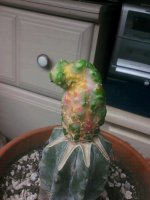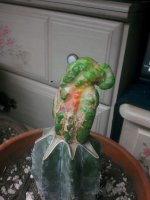Cactus "Chimera"
So I posted this in another forum, but I figured you all would find this interesting. Thanks for reading!
A chimera is something that rarely happens and only happens in cultivation (never in nature... unless somehow two cactus fall on each other perfectly and a graft happens and the very rare chance that a chimera forms happens ;D). It is when two different cactus (grafted to each other) form into one plant becoming an entirely different plant. It is basically two plants in one body. It happens in extremely rare circumstances, usually in a commercial setting where there are several hundred grafts of the same two species. The two plants actually "fuse" together into the same body and a pup protrudes out of the point of contact between the stock and scion becoming two different species fighting it out for growth in the same body. They grow very sporadically and will show characteristics of both species at different times. I'm making this thread just to compile information that I find and so that more and more people gain interest in these amazing mutants.
Here is a better definition from "cactus-art.biz":
"Graft Chimera (synonym: Graft Hybrid) - Graft chimaera (frequently called 'graft hybrids') are cellular hybrids between representatives of two or more named genera. They are a rare phenomenon arising exclusively in cultivation where two species, frequently of two distinct genera, are grafted together.
The mingling of tissues belonging to the stock and scion through grafting in a nonsexual manner. The chimaera come up as a branch or shoot from the point of union which contains tissues of both species, resulting in a arrangement of both species being expressed in the shoot. Such shoots can be vegetatively propagated and cultivated.
The formula for the graft-chimaeral nature of such a plants uses a “ + “ sign against the initial letter of the generic name and to connect the two "parent" species (not the multiplication sign “ X “ this show that they are not sexual hybrids). If intergeneric, graft-chimaeras can be given their own genus name (which is a combination of the two constituent generic names) preceded by a + sign. An example is: + Ortegopuntia (Ortegocactus macdougalii + Opuntia compressa). Graft chimaeras can be given cultivar names. The example above has been named +Ortegopuntia cv. Percy, They cannot be given species names.

+ Ortegopuntia cv. Percy (graft-chimera)
Chimeras in the the Cactaceae family: Chimaeras of plants belonging to the Cactaceae family are very rare and quite unusual in cultivation. The first chimera + Hylocalycium (Hylocereus undatus + Gymnocalycium mihanovichii forma rubra “cv. Red Hibotan”), was described in cactus & succ .J. of America 1987 61- 4 2,
Recently some other chimerical cactus have been signalled in internet for example:
+ Myrtillocalycium (Myrtillocactus geometrizans + Gymonocalycium cv. Red Hibotan)
+ Myrtillocalycium (Myrtillocactus cochal + Gymonocalycium cv. Red Hibotan)
Gymnocalycium mihanovichii v. fleischerianum + Echinopsis tubiflora
Gymnocalycium mihanovichii v. fleischerianum + Hylocereus guatamalensis
Ariocarpus retusus + Echinopsis eyriesii"
More Examples:
+ Myrtillocalycium cv. POLYP (Chimera)
(Myrtillocactus geometrizans (or someteims M. cochal) + Gymnocalycium mihanovichii cv. RED HIBOTAN)




(Myrtillocactus geometrizans (or someteims M. cochal) + Gymnocalycium mihanovichii cv. RED HIBOTAN)




Origin: Garden origin (Nursery produced cultivar)
Etymology: It is thought to be a graft-chimaeras between Mytillocactus geometrizans (or cochal) and Gymnocalycium mihanovichii cv. RED HIBOTAN. Its generic name + Myrtilloclycium comes from those of its parents ("Mytillocactus" and "Gymnocalycium") A graft-chimaeras can be given their own genus name (which is a combination of the two constituent generic names) preceded by a + sign.
Description: Myrtillocalycium 'Polyp' is a graft chimera (bigeneric cactus chimaera) between Myrtillocactus geometrizans (or cochal) and Gymnocalycium cv. Red Hibotan, it is a very colourful red and green columnar cactus This plant is quite unstable and have a tendency to revert to common red Gymnocalycium shoots.
This plant is a mixture of these two plants:
Myrtillocactus geometrizans -

Gymonocalycium cv. Red Hibotan -

Gymnocalycium mihanovichii variegata + Hylocereus undatus

Gymnocalycium mihanovichii v. fleischerianum + Echinopsis tubiflora.

Ariocarpus retusus + Echinopsis eyriesii

Gymnocalycium mihanovichii v. fleischerianum + Hylocereus guatamalensis
If anyone can find a picture please post it. Thanks!
Ariocarpus scapharustrus + Myrtillocactus geometrizans


Gymnocalycium mihanovichii v. fleischerianum + Echinopsis tubiflora.

Ariocarpus retusus + Echinopsis eyriesii

Gymnocalycium mihanovichii v. fleischerianum + Hylocereus guatamalensis
If anyone can find a picture please post it. Thanks!
Ariocarpus scapharustrus + Myrtillocactus geometrizans

If you can find anymore information or chimeras then please post them and your sources. Thanks!
Sources:
http://cactustown.ca/index.php?main_page=product_info&products_id=89
http://www.kaktusy.com.pl/pliki/kurioza/chimery.html
Myrtillocalycium "POLYP"
http://cactusloft.com/actualizaciones/2013-07-03/pagina_1.htm
Other cacti in the Southern hemisphere


